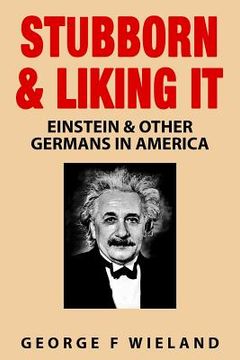Reseña del libro "Stubborn & Liking It: Einstein & Other Germans in America (en Inglés)"
Germans are often stereotyped as stubborn. Among Germans, Swabians like Albert Einstein are considered the most stubborn. Some stubbornness is positive, a single-minded focus on personal projects. Such people are happy, doing what they love. Einstein spent three decades unsuccessfully trying to combine gravity and quantum mechanics. He once explained: "If you want to live a happy life, tie it to a goal, not to people or objects." Other immigrants from the last three centuries include Conrad Weiser who learned the Mohawk Indian language and spent his life mediating between whites and Iroquois Indians-even after he lost his pay and official position. Nineteenth-century German communistic communes came to await the Second Coming of Christ. When it didn't happen, they continued to hope, and their communes lasted much longer than others founded by Americans. Similarly, personal interviews of second and third generation Nebraska homesteaders describe how they endured privations and outlasted Americans who sold out. Such persistence is based on intrinsic motivation, on internal feelings of satisfaction. In contrast, extrinsic motivation is aimed at external goals, such as money, prestige, or avoiding pressures. These objectives can be withdrawn or their potency may wane. People with intrinsic motivation have an enduring internal focus, not an external one. Playwright Bertolt Brecht is another historical character with intrinsic motivation. Forced by the Nazis into exile, he no longer had German-speakers for actors or audiences. However, over thirteen years he continued writing "for the drawer." German Jews were also stubborn. For five years after the advent of Hitler, they remained committed to remaining Germans despite abuse. Immigration quotas for America remained unfilled. With the terrible Crystal Night pogrom, Jews finally started to relinquish their intrinsic commitment to Germany. Other examples of changes in motivation are described. One destitute post-World War II immigrant wanted to become a millionaire. His excessive emphasis on extrinsic rewards created health problems, which he finally solved by emphasizing the process of work, doing good workmanship, not maximizing the money. Another postwar immigrant, a war bride, tells of religion being taught in school, the grades being extrinsic rewards. After years of struggle with the doctrines of the Catholic Church, she developed a personal intrinsic spiritual path. Interviews detail people's backgrounds in Germany including the ascent of the Nazis to power, membership in Hitler Youth, being bombed, and living under the American occupation. These stories combine history and explanations of immigrants' motivations. Important in the development of intrinsic motivation is autonomy, the freedom to act. Parents and teachers relying on extrinsic rewards, even praise, will not create durable intrinsic motivation. Children with the freedom to choose will sometimes fail, but even negative experiences may foster intrinsic commitment. A classic psychological study found that the hazing of fraternity members could paradoxically foster strong intrinsic commitment. People try to make sense of experiences and integrate negative outcomes to yield durable commitments. Thus, a lover can come to see the beloved as desirable, warts and all. Wieland explains that with our instinctual drive to grow, for curiosity and efficacy in actions, we all have, like Einstein and others in the book, the potential to develop intrinsic motivation and associated happiness. The book provides over 300 references for the textual points made. The full sources are listed at the end of the book, keyed to the textual references. A full index in included, showing the depth of the topics covered and how they are organized.

